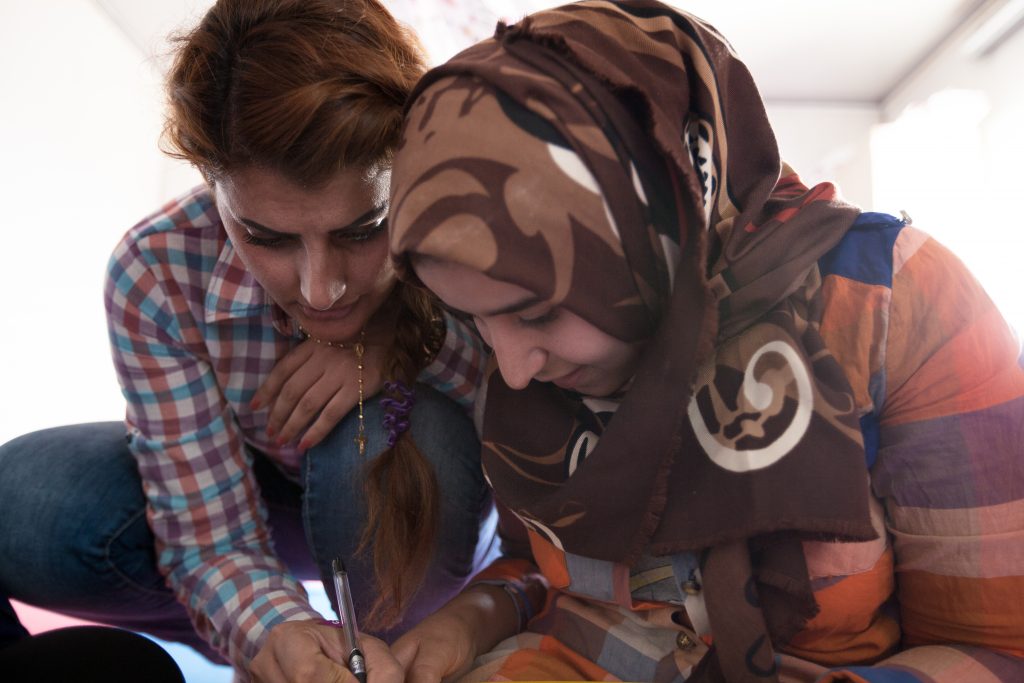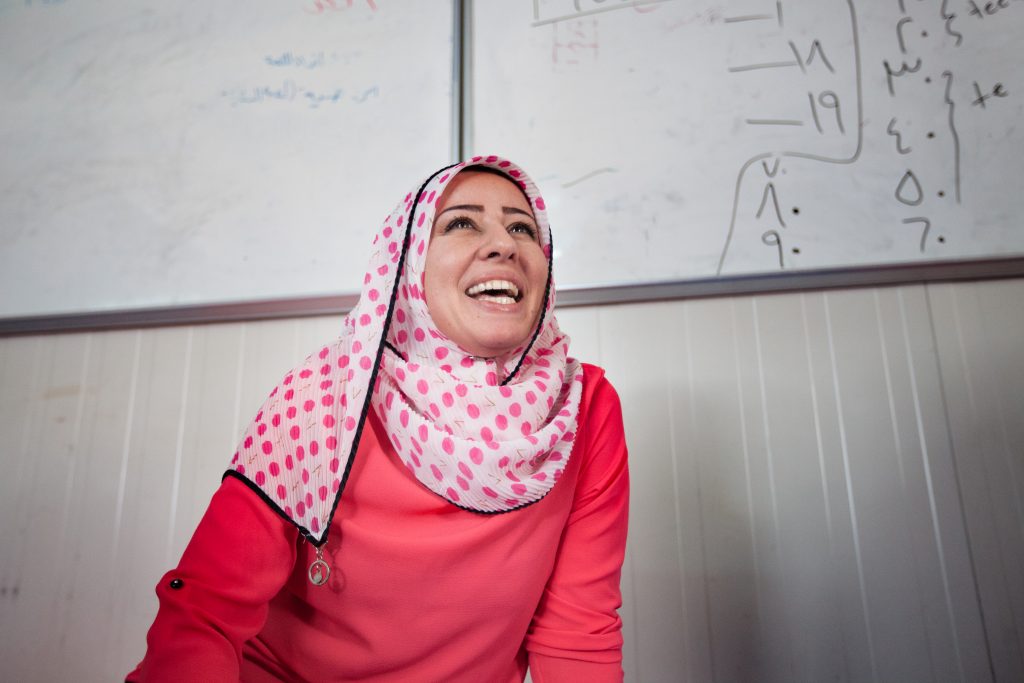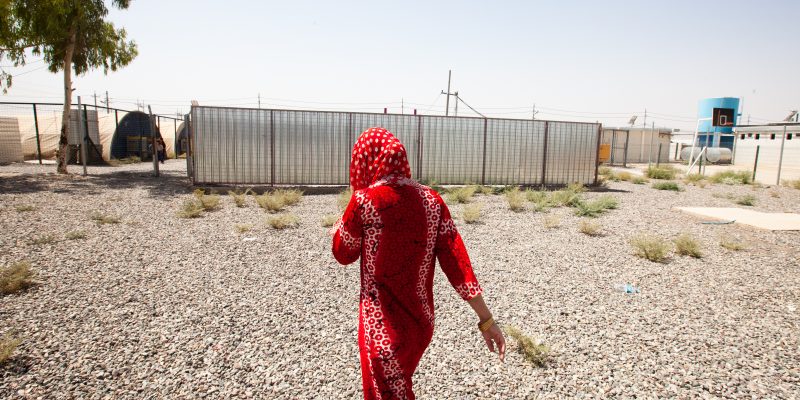In a suburb northeast of Erbil at the Kasnasan clinic for reproductive health operated by Un Ponte Per, hundreds of women are waiting in the central corridor. Most of them are sitting; others are standing or running after small children. The majority of them are conspicuously pregnant, and all are waiting for the one gynaecologist available. The women come from Syria and Iraq, and have been displaced by the war or the Islamic State.
In addition to being a borderland, Kurdistan is a state that never was. It encompasses close to 450,000 square kilometres of mountainous territory, and spans four countries: Turkey, Iran, Iraq and Syria. With a population of about 25 million, it is the largest nation in the world without its own independent state.
Bounded by the steppes of Mesopotamia, the Anti-Taurus Mountains and the Iranian Plateau, Kurdistan is one of those areas which was created by artificial lines furtively drawn a century ago by two men: British diplomat Mark Sykes and his French colleague Georges Picot.
Located along important communication routes, it is a strategic territory as well as an influential one given the abundance of petroleum and other natural resources in the area. Therefore, in order to understand its geopolitical role in modern-day Middle East, one needs a historical and political overview of this strategically relevant region.
Towards the end of World War I, in 1916 a secret pact known in history books as the Sykes-Picot Agreement drew arbitrary border lines over the lands that at that time were still formally under the rule of the Ottoman Empire (1915-1918).
This agreement laid the groundwork for the reorganization of the area and the creation of national states according to a European model. However, it failed to consider the overlapping social, clan and religious structures that to this day play a role in the administration and local affairs of that vast territory.
At around the same time as US President Thomas Woodrow Wilson was espousing the principles of self-determination, the first nationalist tendencies in the region of Kurdistan began to emerge.
The Treaty of Sèvres (August 10, 1920) apparently met the demands of the Kurdish population, and for decades Articles 62, 63 and 64 constituted proof of their rights; however, they similarly constituted proof of promises broken, for the articles had also envisaged the creation of a Kurdish national state.
Political developments and the rise of Turkish nationalism, spearheaded by Mustafa Kemal, resulted in the rejection of the Treaty of Sèvres. It was replaced by the Treaty of Lausanne (July 24, 1923), which did not take into consideration the claims of the Kurds or their national rights, not even as a minority.
As a result, the Kurds found their homeland divided by artificial borders. Persecuted. Crushed by assimilationist policies, and fragmented on a cultural, linguistic, political and socio-economic level.
Which unity?
Rasha and Aya have been refugees twice. The first time was in 2013 after the fall of Saddam Hussein’s regime. The second time was in 2014 with the arrival of the Islamic State.
“It’s not the job that I had in mind, but I feel very lucky compared to those who live here in the camp,” says Aya, who has a medical degree, from inside the van that has been converted into a mobile hospital unit.
Along with other women doctors, Aya visits several camps a day outside Erbil, providing medical and gynaecological assistance to the more vulnerable and isolated among the women.
“I’d like to go home, but where is home?” the twenty-six-year-old wonders. “I hope I can train as a gynaecologist and keep doing this job, but it’s complicated to imagine a future,” she concludes.

Hasham camp for displaced persons – PH: Arianna Pagani.
While today’s Middle East is primarily the product of the divisions among the colonial powers that were engaged in the Great War, it is also true that there were many opportunities to dissolve those borders. A closer look at the past relationships between all the various factions reveals an abundance of internal strife.
One need only consider the relationship between Iraqi and Turkish Kurds: the Iraqi Kurdish government led by Barzani has struck a commercial and political deal with Turkey (one of its main trade partners and purchasers of oil), in exchange for common opposition to PKK – Abdullah Öcalan’s Kurdistan Workers’ Party, which has been engaged in a decades-long armed struggle against the Turkish state. Another, more recent example of Kurdish internal tension was the occupation of the Sinjar Mountains by the Islamic State in the summer of 2014. On that occasion, the military forces of Iraqi Kurdistan, the Peshmerga, withdrew from the region, and thousands of displaced people had to rescued by Syrian Kurdish forces and the PKK.
Today the Peshmerga – literally those who confront death – have erased the Sinjar retreat from their narrative while claiming to have defended and liberated the area. At the same time, the PKK maintains military control of the territory and is unwilling to relinquish it.
These are only a few examples that illustrate the complexity and intricacies of the Iraqi-Turkish zone. Furthermore, in Syria, the Kurds who aligned themselves with the Free Syrian Army in the early phase of the conflict have now sided with the regime, as in the case of the march on Aleppo when, after government troops withdrew from Kurdish regions in north-eastern Syria, Syrian Kurds were left with relative autonomy.
Paradoxically, then, there is a common struggle but not a common goal, as each individual group has, for at least a century, been mired in power plays with local and international actors and no one seems to be able, or willing, to stop.
Iraqi Kurdistan
Despite Iraqi Kurdistan being considered a safe haven and enjoying autonomy from Baghdad’s central government, in recent years social, political, economic and international unrest has threatened its very fabric.
The region is experiencing a severe political and economic crisis. Oil is the main source of wealth in Kurdistan, and its society is dependent on the sales of crude. Despite its abundance, the economy has not been diversified and with the drop in oil prices, all of society has been affected to the point that public wages have been suspended or delayed.
The political scene is dominated by two parties: the PUK (Patriotic Union of Kurdistan) and the KDP (Kurdistan Democratic Party), led respectively by Jalal Talabani and Masoud Barzani according to a clan-based, familistic system. It was destabilized by the rise of the new Gorran (change) movement, which opposes feudal ruling.
All of this has been compounded by the social pressure caused by the presence of a high number of IDP and refugees. Since the beginning of the Syrian conflict in 2011 and the occupation of several Iraqi cities by the Islamic State in 2014, the number of Iraqi IDP has exceeded three million, and the country hosts a little less than 250,000 Syrian refugees.
Twice displaced
Both of them graduated in Baghdad: Aya is a doctor and Rasha a civil engineer. Thanks to two Italian NGOs, Terre des Homes and Un Ponte Per, both are now working to help other women.
Rasha also works for other IDPs. She is an informal educator in the Harsham refugee camp, a few kilometres from the centre of Erbil. Unlike the camps one sees in Lebanon, conditions here are better. Tents have been replaced by steel prefab boxes, the roads within the camp are paved, the entrances are gated and there is a permanent hospital unit. About one thousand and five hundred people from the Nineveh governorate are here; many of the children who live in the camp have never been to school.
Rasha explains what life is like for a woman in Iraq and what the everyday difficulties are, especially for those who grow up in rural areas. Her large eyes twinkle as she speaks. A bright pink headscarf lights up her face. “The biggest problem is for girls, they’re the ones who have it the hardest because their parents won’t let them mix with the boys in the education centres,” she explains. “Those who come from the villages think that a woman’s place is in the house, looking after the children.”
She is an energetic, confident woman who has suffered a lot but has no interest in showing it. She tells her story: the escape from Baghdad, her father’s disappearance (a Sunni with ties to Saddam Hussein), the new beginning in an another city and then having to run again, this time from the Islamic State. A tear runs down her face. “Now I feel at peace in Erbil, but I am worried for my daughters, because it’s hard for Arabs to get access to Kurdish schools,” she exclaims.

Camp for displaced persons in Harsham, Erbil, Iraq – where Rasha works with Terres des Hommes – PH: Arianna Pagani.
Dreaming of return
Adla Bargis is a Syrian Kurdish woman from a village outside Kobane. Since arriving in Erbil, she has been living in a rented house. “I came here with all my family,” the elderly woman recounts with a toothless smile. “I want to go back to Syria as soon as possible, because that’s where my home is.” Like the other elderly women at the clinic, she is here with her daughter-in-law: “She is three months pregnant, but we hope the baby can be born and brought up in our home,” she says.

Aja. PH: Arianna Pagani.
While they are waiting to be visited, the women feel the urge to talk. They complain about financial difficulties, about how hard it is to live in a country they did not choose, and how they all dream of returning home. They are not alone. Rawnaq wonders when she will be able to go home, too. She is a Christian Assyrian and works at the practice as a nurse: “Many times I have thought of going to work in Europe, but eventually I decided to stay here [in Erbil] because Mosul is where I want to go.”
Since the arrival of the Islamic State in June 2014, most of the minorities – Chaldean, Assyrians, Yazidis and Turkmens – have left Mosul, but roughly two million people remain trapped within the ISIS stronghold. Only a few weeks ago, the International Red Cross warned that over a million civilians could be displaced in the coming months due to the liberation of Mosul. That number may actually be much higher. Miriam Ambrosini, project chief of Terre des Hommes, explains: “It will be a large humanitarian crisis, but everything hinges on liberation efforts.”
The future of Mosul and of those displaced in Kurdistan will depend on how the final offensive is conducted and whether sectarian violence can be averted; but, most importantly, it also depends on whether the ground will be laid for people to be able to safely return to their homes.
Translation by Francesco Graziosi & Alexander Booth.









